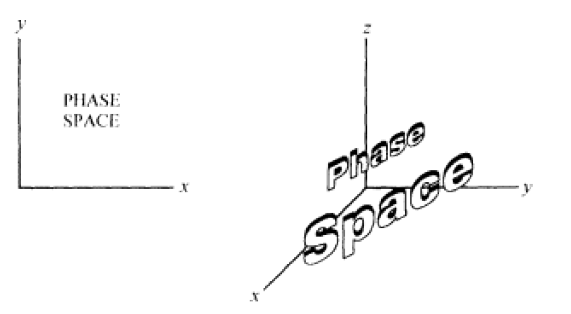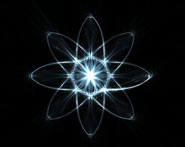


 الفيزياء الكلاسيكية
الفيزياء الكلاسيكية
 الكهربائية والمغناطيسية
الكهربائية والمغناطيسية
 علم البصريات
علم البصريات
 الفيزياء الحديثة
الفيزياء الحديثة
 النظرية النسبية
النظرية النسبية
 الفيزياء النووية
الفيزياء النووية
 فيزياء الحالة الصلبة
فيزياء الحالة الصلبة
 الليزر
الليزر
 علم الفلك
علم الفلك
 المجموعة الشمسية
المجموعة الشمسية
 الطاقة البديلة
الطاقة البديلة
 الفيزياء والعلوم الأخرى
الفيزياء والعلوم الأخرى
 مواضيع عامة في الفيزياء
مواضيع عامة في الفيزياء|
Read More
Date: 26-11-2020
Date: 28-12-2016
Date: 10-3-2021
|
Phase Space—the Playing Field
We'll begin by setting up the arena or playing field. One of the best ways to understand a dynamical system is to make those dynamics visual. A good way to do that is to draw a graph. Two popular kinds of graph show a system's dynamics. One is the ordinary time-series graph that we've already discussed. Usually, that's just a two-dimensional plot of some variable (on the vertical axis, or ordinate) versus time (on the horizontal axis, or abscissa).
Right now we're going to look at the other type of graph. It doesn't plot time directly. The axis that normally represents time therefore can be used for some other variable. In other words, the new graph involves more than one variable (besides time). A point plotted on this alternate graph reflects the state or phase of the system at a particular time (such as the phase of the Moon). Time shows up but in a relative sense, by the sequence of plotted points (explained below).
The space on the new graph has a special name: phase space or state space (Fig. 1). In more formal terms, phase space or state space is an abstract mathematical space in which coordinates represent the variables needed to specify the phase (or state) of a dynamical system. The phase space includes all the instantaneous states the system can have. (Some specialists draw various minor technical distinctions between "phase space" and "state space," but I'll go along with the majority and treat the two synonymously.)

Figure 1: Two-dimensional (left diagram) and three-dimensional phase space.
As a complement to the common time-series plot, a phase space plot provides a different view of the evolution. Also, whereas some time series can be very long and therefore difficult to show on a single graph, a phase space plot condenses all the data into a manageable space on a graph. Thirdly, as we'll see later, structure we might not see on a time-series plot often comes out in striking fashion on the phase space plot. For those reasons, most of chaos theory deals with phase space.
A graph ordinarily can accommodate only three variables or fewer. However, chaos in real-world situations often involves many variables. (In some cases, there are ways to discount the effects of most of those variables and to simplify the analysis.) Although no one can draw a graph for more than three variables while still keeping the axes at right angles to one another, the idea of phase space holds for any number of variables. How do you visualize a phase space with more than three variables or dimensions? Perhaps the easiest way is to stop thinking in terms of a physical or graphical space (such as three mutually perpendicular axes) and just think in terms of number of variables.
Systems having more than three variables often can be analyzed only mathematically. (However, some tools enable us to simplify or condense the information contained in many variables and thus still use graphs advantageously.) Mathematical analysis of systems with more than three variables requires us to buy the idea that it is legitimate to extend certain mathematical definitions and relations valid for three or fewer dimensions to four or more dimensions. That assumption is largely intuitive and sometimes wrong. Not much is known about the mathematics of higher-dimensional space (Cipra 1993).
In chaos jargon, phase space having two axes is called "two-space." For three variables, it is three-space, and so on.
Chaos theory deals with two types of phase space: standard phase space (my term) and pseudo phase space. The two types differ in the number of independent physical features they portray (e.g. temperature, wind velocity, humidity, etc.) and in whether a plotted point represents values measured at the same time or at successive times.



|
|
|
|
الآثار الجانبية لأدوية تستخدم في علاج "ألزهايمر" تثير الجدل
|
|
|
|
|
|
|
اكتشاف سر نجاة "مخلوقات أبدية" من انفجارات الإشعاع القاتلة
|
|
|
|
|
|
أولياء الأمور: حفل الورود الفاطمية للتكليف الشرعي يحصن بناتنا من التأثر بالأفكار المحيطة بهن
|
|
|
|
تربويات: الورود الفاطمية لتكليف الطالبات مشروع حيوي لبناء مجتمعٍ سليم
|
|
|
|
تربويون: مشروع الورود الفاطمية ينتج جيلاً محتشماً ملتزماً بالحجاب وتعاليم الدين الإسلامي
|
|
|
|
الشؤون النسوية: مشهد حفل التكليف الشرعي له وقع كبير في نفوس المكلفات
|